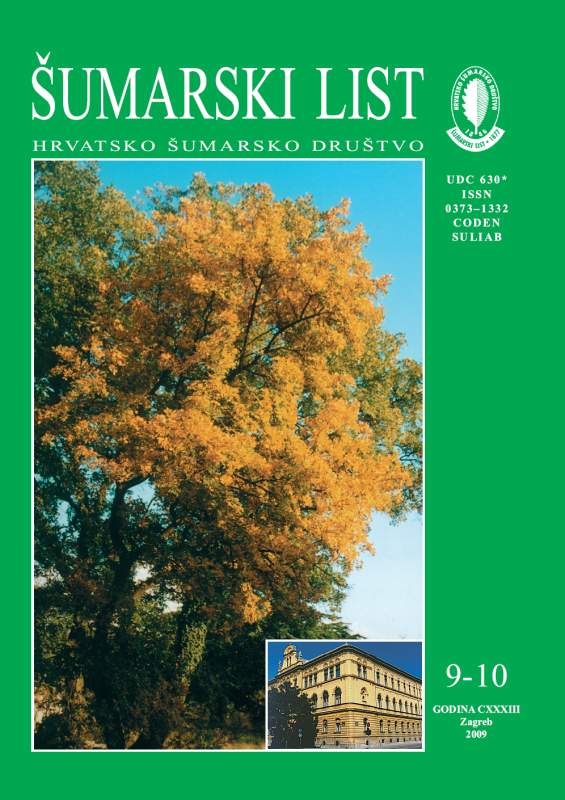
broj: 9-10/2009
pdf (8,1 MB) |
|
||||||||||||||
| RIJEČ GLAVNOGA UREDNIKA | ||
| Branimir Prpić | ||
| ON THE ORGANISATIONAL STRUCTURE OF THE COMPANY “HRVATSKE ŠUME” Ltd pdf HR EN | 468 | |
| IZVORNI ZNANSTVENI ČLANCI | ||
| Seletković,I., N. Potočić,A. Jazbec,T. Ćosić,T. Jakovljević | UDK 630* 232.2 + 232.3 (001) | |
| The Influence of Various Growing Substrates and Slow-release Fertilizers on the Growth and Physiological Parameters of Common Beech (Fagus sylvatica L.) Seedlings in a Nursery and Following Planting in the Field pdf HR EN | 469 | |
| Tanušev,V., J. Ištvanić, M. Moro, J. Butković | UDK 630* 333 + 83 (001) | |
| Yield of Low Quality and Small-Sized Diameter Common Beech (Fagus sylvatica L.) Logs in Rough Dimension Stock Production pdf HR EN | 483 | |
| Summary: By agreement, and in practice sometimes without that agreement, to sawmills sometimes are delivered logs which do not fit regulations for standard saw logs. Often those logs are below standard quality or dimensions. Namely, sawmills compensate the lack of standard saw logs, in aspiration to fully use own capacities, by processing round wood with smaller dimensions; so called thin round wood. In this form of sawmill raw material, diameter dimensions and more often quality are below regulations for sawmill raw materials (sawmill logs). Diameter of thin round wood can range from 15 to 24 cm, and length can range from 2 m and above. Apart from thin round wood, high quality stacked wood in form of split or round wood (pulpwood, firewood, chemical conversion wood and others) can be used as input raw material. Nevertheless, that sort of raw material is infrequently used in large industrial sawmills, due to the problematic profitability of sawmill processing and unique sawmill technological basis. Considering the yield at sawing of these logs it is apparent that it is different from yield at processing of standard sawmill raw material. Research aim of this paper was to determine volume yield, lumber value yield and log value yield of common beech (Fagus sylvatica L.) logs with smaller diameter and quality during their processing dimension stock and flooring components. The study is based on common beech trees harvested in Bosnia and Hercegovina. The object of research were beech logs divided into three groups with mid diameter ranging from 18 to 20, 21 to 23 and 24 to 26 cm (Table 1 to 3). Primary sawing of logs was performed by using live sawing technique on long band saw. All obtained sawn boards were sawn up into dimension stock and flooring components by cross – rip sawing method. The best log volume yield in the form of dimension stock and flooring components showed logs with mid diameter ranging from 24 to 26 cm, followed by logs with diameter from 21 to 23 cm, and logs with diameter from 18 to 20 cm, with mutual insignificant difference (Figure 1 and Table 8). Results show that the best quality dimension stock and flooring components were sawn from logs with mid diameter ranging from 21 to 23 cm, followed by logs with diameter from 24 to 26 cm, and logs with diameter from 18 to 20 cm (Figure 2 and Table 9) . The best log value yield results showed logs with mid diameter ranging from 24 to 26 cm, followed by logs with diameter from 21 to 23 cm, and logs with diameter from 18 to 20 cm (Figure 3 and Table 10). The results confirmed some previous research. They indicate the possibility of successful processing of this kind of raw material regarding the research of technological criteria. In doing so, raw material selection and its qualitative classification is very important. Quality criteria and dimensions of dimension stock and flooring components which will be produced from that raw material are also important. In this paper the usage of three very confined diameter groups was compared. It was determined that there is slight but insignificant mutual difference. With further research it should be considered if there is any sense comparing such confined diameter groups, namely experiments should be set so that wider diameter groups are compared. Considering the market status of beech sawmill products, more attention should be given to economic indicators and success criteria of sawmill processing of this form of sawmill raw material. Key words: Common beech (Fagus sylvaticaL.); dimension stock; log value yield.; log volume yield; low quality and small-sized diameter logs; lumber value yield; sawmilling production | ||
| Šušnjar, M., D. Pičman,T. Pentek, D. Horvat, H. Nevečerel, K. Greger | UDK 630* 383 + 432 (001) | |
| Working Characteristics of Terrain Leveler Machine in Forest Fire Road Construction and Carst Melioration pdf HR EN | 493 | |
| Ballian, Dalibor | UDK 630* 165 (001) | |
| Genetic Structure of Silver Fir (Abies Alba Mill.) from Western and Eastern Bosnia pdf HR EN | 501 | |
| Bobinac, M., S.Andrašev | UDK 630* 25 (001) | |
| Effects of Silvicultural Measures in Devitalized Middle Aged Oak Stand (Quercus Robur L.) on Chernozem in Vojvodina pdf HR EN | 513 | |
| Farkaš,V., T. Gomerčić, M. Sindičić,V. Slijepčević, Đ. Huber,A. Frković, S. Modrić | UDK 630* 156 (001) | |
| CraniometricalAnalysis and Determination of Sexual Dimorphism in Brown Bear (Ursus arctos L.) from Croatia pdf HR EN | 527 | |


